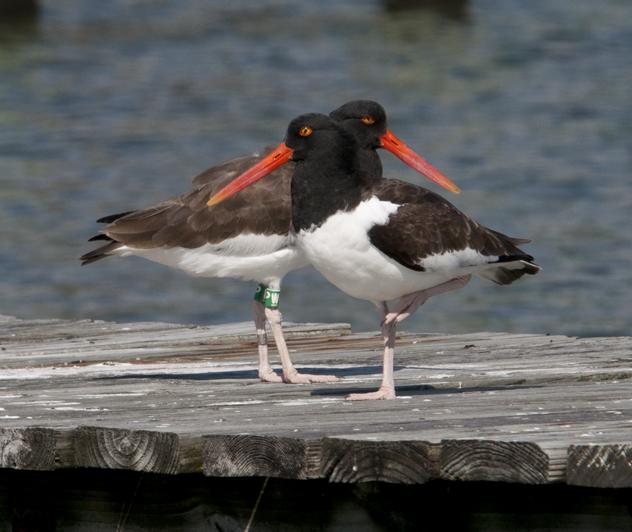Coordinating across eight agencies to count vulnerable shorebirds

Managing American Oystercatchers requires coordinating between many different organizations. Credit: L. Addison
American Oystercatcher (Haematopus palliates) nests are sparsely distributed, time-intensive to find, and often in remote locations, all adding to the challenge of estimating the size of their breeding population.
However, a new study in The Condor: Ornithological Applications demonstrates that a new, simplified survey method, coordinated across 8 agencies, has tremendous potential to provide accurate population estimates and aid in the species' conservation.
Rather than searching for and counting each individual nest, researchers recorded how many oystercatchers they observed within suitable nesting habitat and then modeled the size of the breeding population from this data.
Nathan Hostetter of North Carolina State University and his colleagues in the American Oystercatcher Working Group (amoywg.org) surveyed 93 plots across coastal North Carolina and the eastern shore of Virginia. Multiple agencies, including Audubon North Carolina, the Cape Hatteras National Seashore, North Carolina University, and Virginia Department of Game and Inland Fisheries, collaborated to survey all 93 plots using the same protocol in a single breeding season in 2013.
They estimated that the population of oystercatchers within the survey area was 1,048 individuals, and comparisons with more exhaustive surveys in a subset of the study area show that this number is likely accurate.
“Our study developed as part of larger efforts to investigate Atlantic coast American Oystercatchers across their entire range,” explains Hostetter. “Our ability to utilize data collected by multiple agencies that often independently monitor American Oystercatchers was exciting and shows great promise for future range-wide surveys. Standardizing field methods and protocols required a lot of pre-season brainstorming and effort from all agencies. The ability to integrate studies at the end of the season, however, was extremely rewarding and provided insights at spatial scales that no single agency could accomplish alone.”
“This study will help advance oystercatcher conservation and management because it provides a robust monitoring framework that will facilitate collaboration across agencies and organizations,” adds James Lyons, an oystercatcher expert with the U.S. Fish and Wildlife Service who was not part of the study. “The validation study with intensively monitored sites provides clear evidence that, with the appropriate analytic framework, extensive monitoring can provide reliable information about population status and inform management decisions.”
###
“Repeated count surveys help standardize multi-agency estimates of American Oystercatcher (Haematopus palliates) abundance” is available at http://www.
About the journal: The Condor: Ornithological Applications is a peer-reviewed, international journal of ornithology. The journal began in 1899 as the journal of the Cooper Ornithological Club, a group of ornithologists in California that became the Cooper Ornithological Society.
Media Contact
All latest news from the category: Life Sciences and Chemistry
Articles and reports from the Life Sciences and chemistry area deal with applied and basic research into modern biology, chemistry and human medicine.
Valuable information can be found on a range of life sciences fields including bacteriology, biochemistry, bionics, bioinformatics, biophysics, biotechnology, genetics, geobotany, human biology, marine biology, microbiology, molecular biology, cellular biology, zoology, bioinorganic chemistry, microchemistry and environmental chemistry.
Newest articles

Properties of new materials for microchips
… can now be measured well. Reseachers of Delft University of Technology demonstrated measuring performance properties of ultrathin silicon membranes. Making ever smaller and more powerful chips requires new ultrathin…

Floating solar’s potential
… to support sustainable development by addressing climate, water, and energy goals holistically. A new study published this week in Nature Energy raises the potential for floating solar photovoltaics (FPV)…

Skyrmions move at record speeds
… a step towards the computing of the future. An international research team led by scientists from the CNRS1 has discovered that the magnetic nanobubbles2 known as skyrmions can be…





















